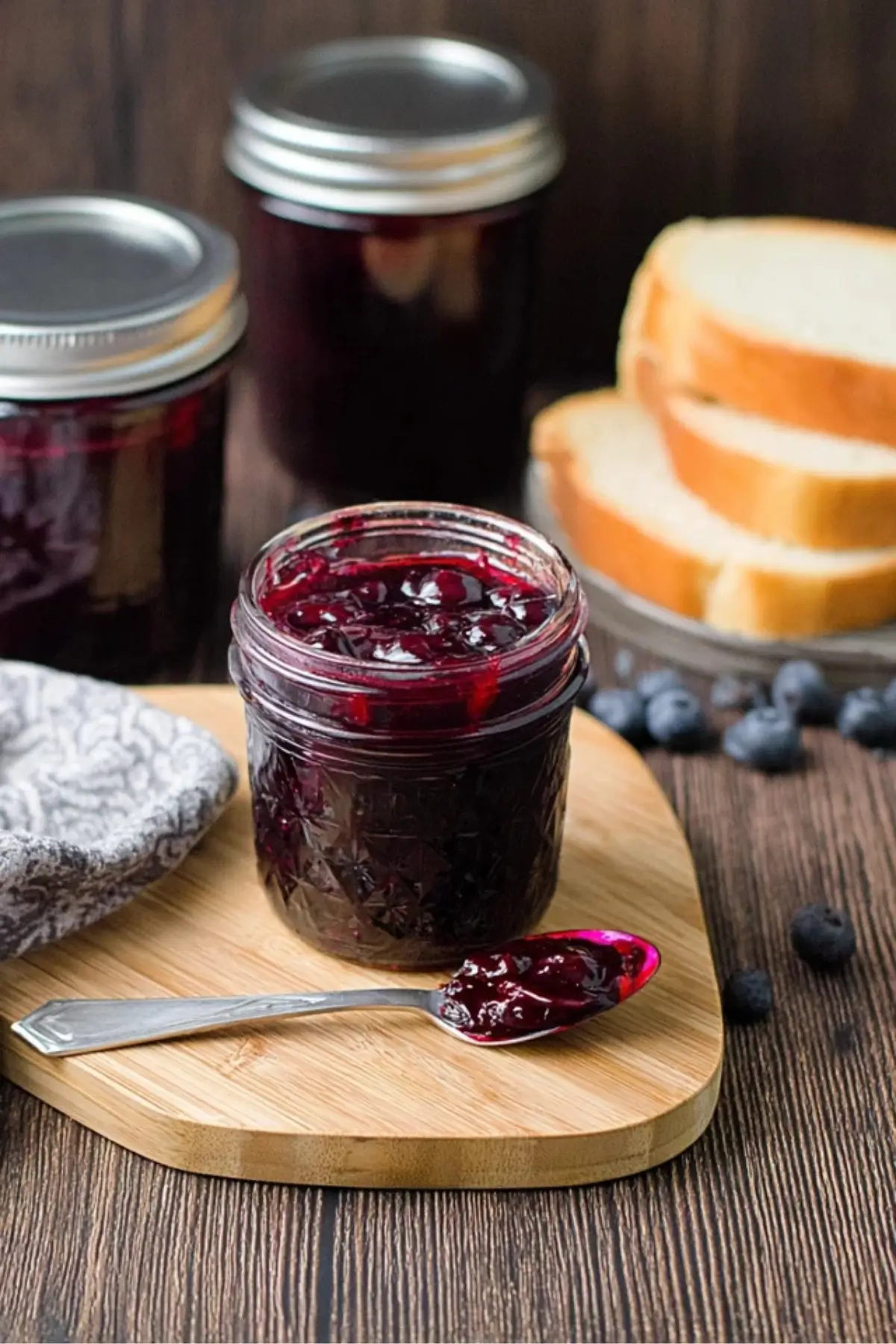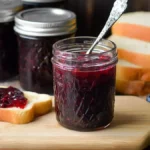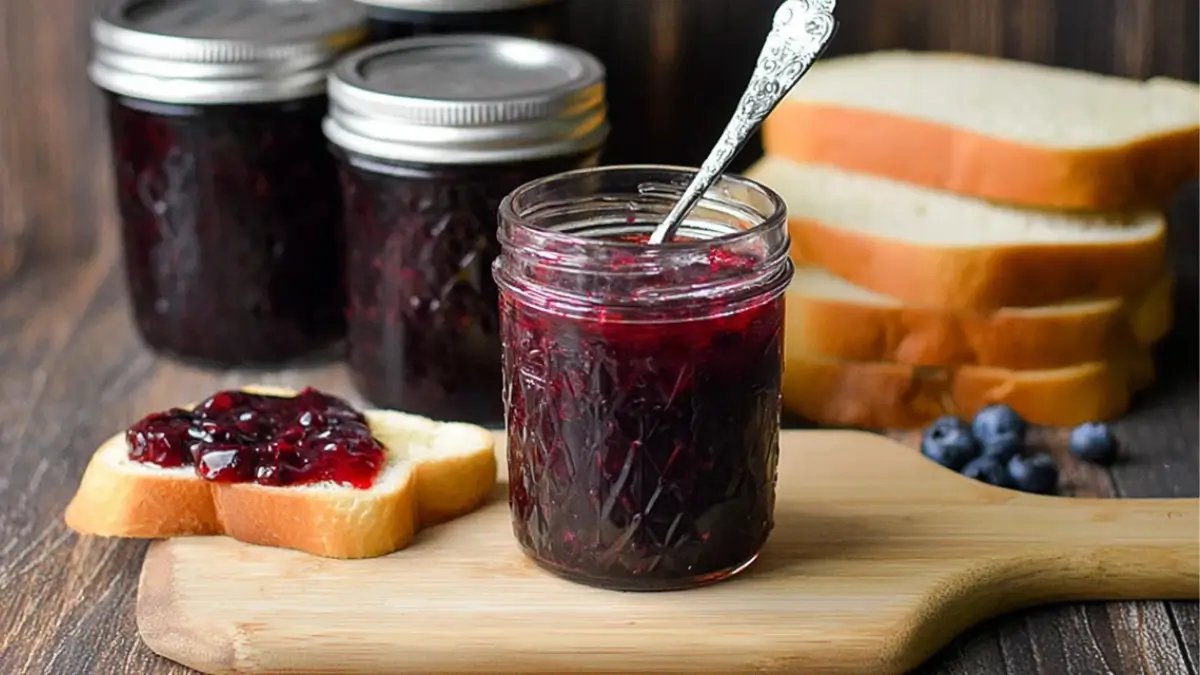Growing up, my grandmother’s kitchen was always filled with the aroma of simmering fruit in the summertime. One of my fondest memories is standing on a stool beside her, stirring a bubbling pot of jam. While strawberry rhubarb was our family favorite, it wasn’t until I experimented with blueberries that I discovered a truly magical combination—blueberry rhubarb jam. It’s sweet, tangy, and incredibly easy to make. This lemon herb chicken recipe of the jam world is perfect for beginner cooks—simple, wholesome, and deeply satisfying. Whether you’re canning for the first time or looking for a new twist on a classic, this easy sheet pan dinner equivalent in jam form is your ticket to a delicious pantry staple.
With just four ingredients and no added pectin, this jam is ideal for those seeking quick and healthy meals—or at least healthier preserves—without sacrificing flavor or fuss.

Why This Recipe is Special
This blueberry rhubarb jam stands out not just because of its vibrant taste but also its practicality. The natural pectin in blueberries helps the jam set beautifully without any need for commercial thickeners. Rhubarb adds that unmistakable tartness, while lemon brightens everything up. It’s a foolproof recipe for anyone new to canning or looking for a no-fuss homemade spread.
Beyond taste, this jam is:
- Time-efficient: Done in about 35 minutes from prep to jar.
- Flexible: Works with fresh or frozen fruit.
- Lower in sugar: No commercial pectin means you can reduce sugar to taste.
- Preservable: A great way to stretch summer fruit into the colder months.
Ingredients and Preparation
Blueberries
These provide the natural sweetness and a rich, jammy base. Their skin breaks down easily, making them ideal for a soft, spreadable texture. They also contribute natural pectin, which is essential for setting the jam without additives.
Substitute idea: You can replace blueberries with blackberries or mixed berries for a deeper flavor.
Rhubarb
This vegetable (yes, it’s technically a veggie) brings a tart edge that cuts through the sweetness and adds a unique sharpness. It cooks down beautifully, giving body and bite to the jam.
Substitute idea: If rhubarb is unavailable, green apples or tart cherries can offer a similar acidity and texture.
White Granulated Sugar
The key to preservation, sweetness, and texture. Sugar draws out the juices and helps gel the jam as it cooks.
Substitute idea: You may use coconut sugar or a mix of honey and sugar for a more natural sweetener profile, but be aware this may affect the set.
Lemon Juice and Zest
Lemon does double duty—its juice boosts acidity for safe canning, and the zest adds brightness and depth.
Substitute idea: Bottled lemon juice works in a pinch, but fresh is best for flavor.
Step-by-Step Instructions
Step 1
In a large pot or jam pan, combine the blueberries and chopped rhubarb with the zest and juice of one lemon. Place the pot over medium-high heat and cook for 5 to 10 minutes, stirring occasionally, until the fruit has softened and released its juices.
Step 2
Once the fruit is tender, use a potato masher (or fork) to gently mash the mixture. This helps break down the blueberries and rhubarb, creating a more consistent texture.
Step 3
Add the sugar to the fruit mixture and stir to combine. Turn the heat up slightly and bring the jam to a gentle boil, stirring continuously to prevent sticking or burning. Continue cooking for 20 to 25 minutes until the mixture thickens and reaches the gel stage.
Step 4
To check if the jam is ready, use the spoon test: dip a spoon in, then let the jam fall off. If it comes down in thick sheets or hangs briefly before dropping, it’s ready. You can also do the cold plate test—place a bit of jam on a chilled plate and run your finger through it. If the line stays clear, it’s set.
Step 5
Once set, remove the pot from the heat. Spoon the hot jam into clean jars if storing in the fridge, or proceed with water bath canning. Fill jars leaving 1/4-inch headspace, wipe rims, seal with new lids, and process in a boiling water bath for 10 minutes.
Step 6
Allow the jars to rest in the hot water for 5 more minutes after boiling, then remove them using a jar lifter. Let them cool on a towel-lined counter for 24 hours undisturbed. Store sealed jars in a cool, dry place for up to 18 months. Refrigerate any unsealed jars and consume within two weeks.
Beginner Tips and Notes
- Jam too thin? Try cooking it for 5-10 more minutes and test again. Lack of set is usually due to undercooking.
- Jam too thick? You may have overcooked it. Add a little water or blueberry juice while reheating it to loosen it.
- Avoid sticking by stirring frequently once the sugar is added. A silicone spatula works great for this.
- No potato masher? A fork, whisk, or immersion blender can help break down the fruit.
- Frozen fruit tip: Always thaw fully and drain excess liquid to avoid overly watery jam.
Serving Suggestions
- Pair with: Toast, yogurt parfaits, pancakes, waffles, or even swirled into oatmeal or cottage cheese.
- Savory ideas: Use as a glaze for pork or chicken, or paired with cheese and crackers for an appetizer.
- Leftover storage: Refrigerate opened jars and use within 10-14 days. For long-term storage, keep sealed jars in a dark, cool pantry for up to 18 months.
- Freezer-friendly: Pour cooled jam into freezer-safe containers leaving space at the top, then freeze for up to 6 months.
Conclusion
There’s something deeply satisfying about making your own jam, especially when it’s as simple and flavorful as this blueberry rhubarb jam. It’s a beginner-friendly gateway into home preserving, and it offers a unique flavor that feels both nostalgic and new. So whether you’re planning a weekend canning project or just want to try a small batch for the fridge, this quick and healthy meal companion is worth every stir. Give it a try and let me know how yours turns out—I’d love to hear your take in the comments.
FAQ About Blueberry Rhubarb Jam
1. Can I use frozen fruit for this blueberry rhubarb jam?
Yes, both blueberries and rhubarb can be used from frozen. Just be sure to fully thaw and drain them before starting to prevent excess liquid in the jam.
2. How do I know when the jam has reached the gel stage?
You can use the spoon or cold plate test. For the spoon test, the jam should fall off in thick sheets. For the cold plate test, a line drawn through the jam should stay clear.
3. Can I reduce the sugar in this recipe?
Yes, since this is a no-pectin recipe, you’re not relying on sugar to activate gelling agents. However, reducing it too much may result in a looser consistency.
4. How long can I store the jam?
Properly canned and sealed jars can last up to 18 months in a cool, dark pantry. Opened jars should be refrigerated and consumed within 10–14 days.
More Relevant Recipes
Print
Blueberry Rhubarb Jam
- Total Time: 35 minutes
- Yield: 5 half-pint jars
- Diet: Vegetarian
Description
A sweet and tangy no-pectin blueberry rhubarb jam recipe, perfect for beginners and ideal for preserving seasonal fruit with a quick and easy method.
Ingredients
- 4 cups blueberries, washed
- 4 cups rhubarb, washed and cut into ¼-inch slices
- 4 cups white granulated sugar
- 1 lemon, zest and juice
Instructions
- In a large pot or jam pan, combine the blueberries and chopped rhubarb with the zest and juice of one lemon. Cook over medium-high heat for 5–10 minutes until the fruit softens.
- Use a potato masher to gently mash the softened fruit for a more consistent texture.
- Add the sugar and bring the mixture to a boil over medium-high to high heat. Stir constantly and cook for 20–25 minutes until the jam reaches the gelling stage.
- To test if it’s set, use the spoon test (jam should fall in sheets) or the cold plate test (run a finger through jam on a chilled plate; it should stay separated).
- Remove the jam from heat. Spoon into clean jars and refrigerate, or water bath can by filling jars with ¼-inch headspace, removing air bubbles, sealing with new lids, and boiling for 10 minutes. Let jars rest 5 minutes in water, then cool on a towel for 24 hours.
Notes
- Frozen fruit can be used but should be thawed and drained first.
- Reducing sugar will lead to a softer set but is still safe if canning guidelines are followed.
- Stir constantly during boiling to prevent scorching.
- Jam can be stored in sealed jars for up to 18 months; refrigerate any unsealed jars and use within 10–14 days.
- Prep Time: 5 minutes
- Cook Time: 30 minutes
- Category: Condiment
- Method: Canning
- Cuisine: American
Nutrition
- Serving Size: 1 tablespoon
- Calories: 45
- Sugar: 10g
- Sodium: 0mg
- Fat: 0g
- Saturated Fat: 0g
- Unsaturated Fat: 0g
- Trans Fat: 0g
- Carbohydrates: 11g
- Fiber: 0.3g
- Protein: 0g
- Cholesterol: 0mg

